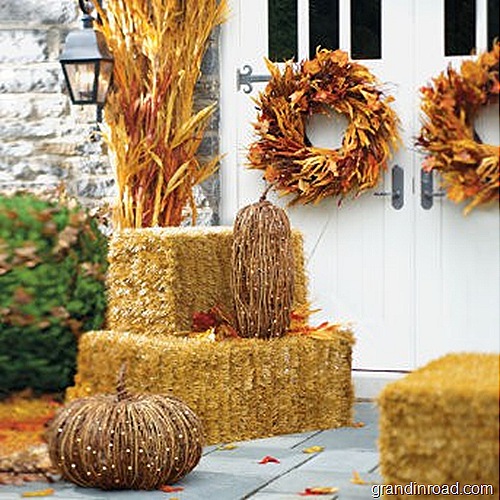Now is the time to start watching for those inviting, organic accessories for your fall decor: corn stalks, grape vines, wheat bundles, and changing leaves.
So how do you get those things for zero out of pocket if it’s not growing in your own yard?
Gleaning.
Do you know what it is? Have you ever done it?
Gleaning is basically collecting left over materials that the owner doesn’t want or need. For fall that means lots of opportunities to score left over wheat, corn stalks, grape vine, etc. after the main crop has been harvested.
If you’ve never tried it, you need to!
But before you start tromping through fields with scissors in hands, consider the following:
1. First and foremost, always always always ask before you take anything. Gleaning without permission is the love child of stealing and trespassing. Knock on the door or call the property owner and make sure it’s okay to glean.
2. If you don’t know who the owner is or how to get a hold of them, call the city or county recorder’s office and get the owner’s contact information.
3. Make sure you have an exact (or very close) address when you stop by or call a city/county clerk. The more information you provide, the quicker and easier it will be for them to help you.
BAD: “I’m looking for the property owner of that big field over by the freeway.”
GOOD: “I’m looking for the property owner of the field on the northeast corner of John Street and 80th Avenue.”
4. When you go to glean, be quick, be respectful, stay out of their way, bring your own equipment (scissors, garbage bags, etc.) and don’t ask for special accommodations. Remember: they’re doing you a favor.
5. Send a thank you note to anyone who helped you: the city clerk, the property owner, whatever. It only takes a few minutes and will make it much more likely that you’ll be welcomed back next year.
What and Where To Glean
My all-time fav:
1. WHEAT
Remember this project from the THRIVE archives?
I made this project using gleaned wheat from my neighbor’s garden after she picked what she wanted. This would have run $20+ at a craft store after the coupon discount.
This year my neighbor didn’t plant wheat so I called the city recorder of the town where I saw a huge field that had just been harvested.
Turns out the city owns that field and they gave me permission right then. Score!
That tiny row of left over wheat right along the dirt patch yielded a bucketful. For wheat, oats or any other cereal grain, put the cut stems in a bucket—using a garbage bag for collection makes a huge mess and often breaks the stems.
2. CORN STALKS
I use them every year on my front door and will this year, too (even though I’m planning some fun, big changes).
Talk to your to friends and neighbors with garden patches now about gleaning their left over stalks. Commercially harvested fields may now have a lot of stalks left over, but small patches that are harvested by hand are great places to look. Bring twine and hedge clippers to lop through and bundle your stalks. Green stalks will need a few weeks to dry completely and acquire that wonderful parchment color.
3. GRAPE VINE
Love, love, love.
But those shapes can get pricey, even with the wonderful 40% off coupons. Making your own shapes is easier than you may think so look around. Ask neighbors, friends, etc. if you can help trim back vines when their grapes have been harvested. They get some help and you get the raw materials to make wreaths, swags, frames, pumpkins, whatever. Win, win.
4. LEAVES
They’re pretty much everywhere which makes this easy. Picking up leaves at a park or along a public walk way is usually no big deal. If you’re worried, it never hurts to call the local city public works department and double check. If you see great leaves on private property, again–always ask before collecting! I’ve seen great leaves on lawns while I’m out running errands, pulled over and gone and knocked on doors before.
My favorite way to use leaves is to string them together on twine or fishing line for a simple, pretty bunting.
I usually store leaves in between the pages of large books while they dry out. The flattened, leathery leaves are easier to use for projects than the more brittle, curled shape you usually get with regular air drying.
5. CORN HUSKS
 Images: 1. Growing Corn 2. Amazon.com
Images: 1. Growing Corn 2. Amazon.com
Sure, you could go guy these at the grocery store, but you can also just save those husks after your next bbq. Trim off the thick, curved bottom end and press the individual husks in between book pages (just like leaves) so they dry smooth and flat. Husks are so under appreciated and versatile. Seriously, make sure you save some.
So go put some scissors, gloves and a bucket in your car and try your hand at gleaning!
Happy
please-for-the-love-let-it-cool-down-soon
Fall!










Comments are closed.